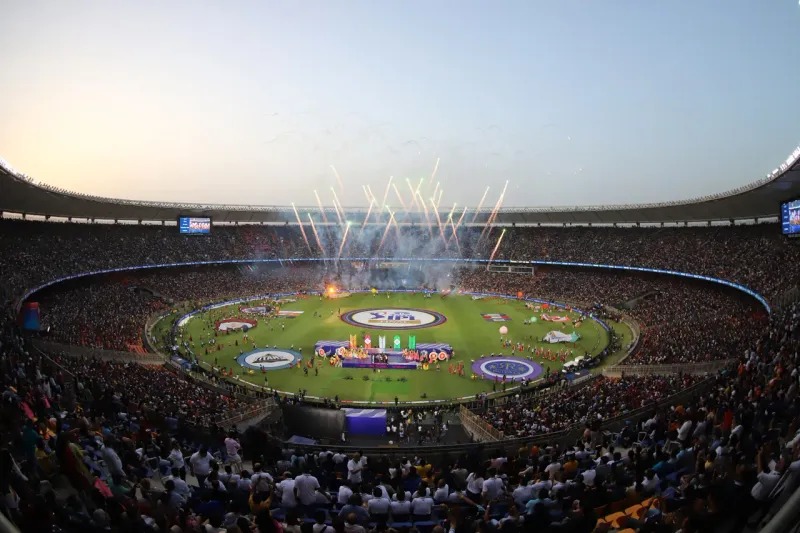
By Sunday night, either the Chennai Super Kings (CSK) would have won the coveted IPL title for the fifth time, or the Gujarat Titans would become only the third franchise (after CSK and Mumbai Indians) to win consecutive titles, and the first to do so in their first two seasons of existence.
The drama-filled, entertainment-led cricketing festival spanning over 59 days would complete its 16th season. The ten participating franchises are now valued at a little more than $1 Billion on average.
The IPL’s media rights alone have seen a meteoric rise in value – from $1.05B in the first five-year cycle to $6.17B in the current one spanning 2023-2027, which were bagged by Disney Star, Viacom 18, and Times Internet.
The media-broadcast value of each IPL game stands at $15.1M, while an English Premier League (EPL) match is currently priced at $11.23M. It’s $12.12M for a Major League Baseball (MLB) game, and $9.57M for an NBA match.
The IPL is still a distant second to American Football’s National Football League (NFL), where each game is valued at $36M. Given the meteoric rise of franchise cricket and the deeper penetration of digital OTT apps, it isn’t utterly unfathomable that the IPL could be the most valuable sporting league in the world in the coming decade.
Beyond the media rights, the IPL earns another $120 million from sponsorships – about $86M from the Tata Group as the title sponsors, and $27M combined from the eight official sponsors in Dream 11, CRED, up, RuPay, Saudi Tourism Authority, Swiggy, Instamart, and Upstox. There’s also the $3.6M from PayTM, who sponsors the umpires, and $3.8M from CEAT as the Strategic Timeout sponsors.
The proceeds from both the broadcast-media rights and the tournament sponsorships are split between the Board of Cricket Control in India (BCCI) and the 10 franchises.
The franchises themselves attract brand sponsors across three categories – Main Sponsors, Principal Sponsors, and other partners. Each franchise can have anywhere between the six sponsor partners the Rajasthan Royals have, and the 25 brands that back the Royal Challengers Bangalore.
These can range from ubiquitous, household names from the world to banking, beverages, and tourism to new-age finTech and fantasy gaming to obscure labs, studios, and plumbing pipes, perhaps representing the myriad companies that empower Indian lives across different socio-economic strata.
Also Read: How the First Night Set the Tone for India’s Enduring IPL Affair
The proceeds from team sponsorships, advertisements, and prize money all go solely into the team kitty. The franchises also retain 80 per cent of the stadium collection from home games, whilst the remaining 20 goes to the BCCI.
The BCCI also retains 100 per cent of the proceeds from the sale of the franchises. Over the 16 years, it has made anywhere between $56M for the Rajasthan Royals to a whopping $897M for the Lucknow Super Giants, bought by the RPSG Group last year.
Collectively, the BCCI would have bagged approximately $2.8 Billion through the sale of the 12 franchises that have been part of the IPL over the years, including the Kochi Tuskers Kerala (a single season in 2011) and Pune Warriors India, who played a cameo act between 2011 and 2013.
The 10 active IPL franchises are valued at a billion dollars on average, with the Reliance Industries-owned Mumbai Indians, who have won the championship five times till date, enjoying the highest valuation of about $1.3B. The private-equity owned Gujarat Titans are valued at $850M after a little more than a year of operations.
The original eight franchises that started playing in 2008 have seen their valuation soar beyond 1700 per cent over the 16 years. Rajasthan Royals, in which Tiger Global recently invested $800M, have seen their brand value appreciate by nearly 3000 per cent, while the Sunrisers Hyderabad franchise’s value is up by 1727 per cent.
When Lalit Modi and crew conceptualized the IPL dream in 2008, who would have thought that the framework of franchise cricket would not only propel the commercials of the sport in such an explosive trajectory, but also transform the way the game is played, consumed and marketed globally? Or that it would change the life of an average player in a manner which they could never have imagined?
Without the IPL, Team India would never have seen the likes of Ravindra Jadeja, Jasprit Bumrah, Hardik Pandya, Mohammed Siraj and T Natarajan make it to the international stage so soon, if at all. We now know how impactful they have each been in their own right across formats.
Even if some may not have played for India yet, the IPL platform has been game-changing for young rookie talents like Rinku Singh, Dhruv Jurel, Suyash Sharma, Sai Sudharsan, Rahul Tewatia, Akash Madhwal, Jitesh Sharma, Nehal Wadhera, Rajat Patidar, Tushar Deshpande, Chetan Sakariya, Devdutt Padikkal and Paul Valthaty.
For the Tier-1 youth like Tilak Verma, Jaiswal, and Sarfaraz Khan, who had anyway announced their arrival through the Under-19, India-A, and domestic tournaments, the IPL further provides a platform to express themselves, and accelerate their growth, both on and off the field.
It is an opportunity for this crop of players to connect with the best on the international circuit that they are soon likely to compete against, a dress rehearsal of sorts to handle success and fame, manage comebacks, and strengthen their minds before the actual international stage.
The IPL has turned player economics on its head for domestic and international players. Amongst the domestic stars, players like Rohit Sharma, Shreyas Iyer, Rishabh Pant, and Deepak Chahar make anywhere between $1.5M to $2M from their respective franchises.
International champions like England’s Sam Curran and Ben Stokes commanded $2.37M and $2M this season. Australia’s Cameron Green makes $2.2M from the Mumbai Indians, whilst South Africa’s Chris Morris, earlier, and the West Indies’ Nicholas Pooran, now, were paid about $2M each by the Rajasthan Royals and the Lucknow Super Giants.
Uncapped players like Rahul Tewatia and Shah Rukh Khan make life-changing sums of $1.1M a year. Folks like Krishnappa Gowtham, Avesh Khan, Varun Chakravarthy, Krunal Pandya, and Tim David not only make a salary of a million dollars but have seen their international debuts catalyzed by the IPL.
Above and beyond this, players stand to make a lot more through brand endorsements, player awards, and other potential corporate engagements.
The IPL has changed the power equation to such an extent that today, Mumbai Indians are contemplating offering Jofra Archer, England’s injury-prone pace ace, a contract that would require the ECB, his home country’s cricket board, to seek permission from the franchise to avail his services.
This will ensure that Archer is available to play in the IPL and other global leagues like the SA20 and the upcoming Major League Cricket in the United States, where the Mumbai Indians own franchises.
The IPL economy has and continues to change the paradigm of cricket. Many predict that cricket will go the football route, where player loyalties lie with the clubs and not their countries of origin.
Purists can continue to criticise and question if the modern-day, entertainment-led, shorter format is the real deal, and there is indeed a lot to debate about the ethical and financial implications of these trends. But it is hard to deny that the IPL has transformed the sport of cricket.
It has made the sport accessible and entertaining for families, globalized it beyond the Commonwealth, provided access, exposure, and opportunities to those who would never have had it otherwise, offered a financial crutch to the classical formats of ODI and Test cricket, and ushered in technological innovation that has made the game arguably fairer. It has also ensured scalable distribution, ushered in diversity and equity through the Women’s Premier League, and elevated performance and fitness expectation from players, coaches, and staff.
This global professionalization of cricket has been fueled and enabled by the revolutionary commercial model of the IPL that has provided brands the opportunity to leverage the popularity of the modern-day game that is consumed through television and digitally by millions globally. The soaring media, sponsorship, and advertising rights, in return are funding the three operating stakeholders – the board, the franchise owners and the players.
Beyond the two-month-long cricket festival every year in the Indian summer, the IPL helps creates thousands of jobs across hospitality, tourism, advertising, sales, player management, security, logistics, event marketing, and retail, to name a few.
May this game-changing platform continue to prevail, grow, entertain, educate, inspire, bridge ties, and, more importantly, provide economic opportunity to our young nation that is poised to become a $10 Trillion economy by 2035.
Also Read: The day world cricket changed forever.




